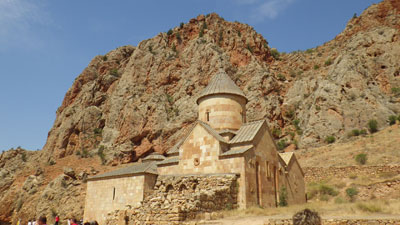South Caucasus comparisons
This item appears on page 15 of the July 2015 issue.
I took the tour “Discover the Caucasus: Armenia, Georgia, Azerbaijan,” Sept. 3-23, 2014, with Original World (San Rafael, CA; 888/367-6147, www.originalworld.com).
The 21-day program cost $5,255 plus a single supplement of $1,322 and, since the group had fewer than six people, a surcharge of $1,045 each.
That group tour was preceded by a 6-day/5-night private tour of the Republic of Georgia’s western section, Aug. 29-Sept. 3, arranged at a cost of $4,395 by MIR Corporation (Seattle, WA; 800/424-7289, www.mircorp.com). It was well organized and went smoothly, and the guide was excellent.
Original World’s tour was handled locally by Caucasus Travel (www.caucasustravel.com). No tour manager accompanied our group. In each country we had a different driver and guide, who checked us into hotels, accompanied us to restaurants, provided commentary, etc. All of the guides spoke excellent English and were experienced, knowledgeable, likable and patient.
The hotels Original World used were quirky, eccentric and inconsistent with one another in terms of quality, service and amenities. They ranged from the 5-star Baku Hilton down to the (dubiously 3-star-rated) Hotel Truso, located in mountainous Gudauri, Georgia — the best-available hotel in town at that time of year. (Gudauri is a ski resort, and most of the better hotels aren’t open outside of ski season.)
There was complimentary Wi-Fi in every hotel. The connection was sometimes weak or nonexistent in my room but fine in the lobby.
The month-long experience of both tours gave me a comprehensive view of this fascinating part of the world. I considered the trip to be time and money well spent.
•
In general, I liked the churches in Armenia better than those in Georgia because they were perched in more dramatic settings. The Tatev Monastery near Goris was the most magnificent monastery we saw in Armenia and easily accessible by a recently built cable car.
The interiors of the Armenian churches were simpler and more plain than their Georgian counterparts, but the façades, with their decorative carvings and engravings, were exquisite.
Most Georgian churches were more impressive in their overall structures than the Armenian churches, and I thought their interiors were more attractive, with numerous frescoes and icons similar to those found in Russia.
Georgia is also known for its cave villages, most notably the one in Vardzia, which was one of the highlights of the trip. We did a lot of walking at this complex — quite a workout! Touring the Caucasus area, especially Georgia, might be a challenge for those who aren’t physically fit.
(One essential item to pack is a pair of hiking boots with good tread. A lot of the steep, hilly paths we climbed to churches and monasteries had cobblestones or loose pebbles underfoot, and surfaces were often wet and slippery. I used a collapsible walking stick, which saved the day.)
In general, I liked western Georgia (the part covered by my private MIR tour) better than eastern Georgia. I considered the Svaneti region to be the most scenic part of the country. I was especially taken with the unique, old stone towers of Mestia, which were floodlit at night. Mre than 200 of these towers still exist in the region.
My guide in western Georgia, Eka Natenadze, was excellent. My only regret was that the private tour wasn’t long enough to include the community of Ushguli in the Upper Svaneti, a UNESCO World Heritage Site. A 2½- to 3-hour drive from Mestia, Ushguli claims to be the highest-altitude permanently inhabited place in Europe.
The Original World itinerary offered an opportunity to walk up the steep hill above the Lavra Monastery in Davit Gareja, Georgia, to the Udabno Monastery and explore some of the 10th- to 13th-century frescoes. Our guide recommended I not try this climb and I wisely listened to her. As it turned out, the refectory containing the frescoes was closed that morning because military exercises were being conducted.
In Azerbaijan, I felt the highlight was the Khan’s Palace in Sheki, with its colored shebeke windows, with thousands of pieces of stained glass set with wood. The painted wall and ceiling murals once had carpets to match. Located in the north, it was absolutely ostentatious but, oh, so wonderful!
In the west, about 40 miles from Baku, Gobustan National Park is a World Heritage Site known for its prehistoric rock art (petroglyphs).
Baku, a large, spread-out city, was not as attractive in the daytime except for the long, park-strewn promenade along the Caspian Sea, but at night it was magically lit up and had an entirely different atmosphere.
In addition to the myriad new buildings that have sprung up since the fall of the Soviet Union and the subsequent oil boom, Azerbaijan has retained some Soviet-style buildings from the Stalin and Khrushchev eras, making structural additions to their façades. The decorative columns and engravings have transformed them and given them a whole new lease on life.
On the more recent and modern end of the scale, a trio of blue-glass skyscrapers known as the Flame Towers was beautifully lit up at night, like flames. The city of Baku has to be seen to be believed. Larger and richer than Yerevan (Armenia) and Tbilisi (Georgia) combined, it is to the Caucasus what Dubai is to the Gulf States.
In all three countries, the museums we visited were excellent, with creative and imaginative displays.
Azerbaijan is probably the most exotic of the three Caucasus nations because it’s the most Asian, with Armenia coming in a close second. Georgia is clearly and squarely a European country.
ADA GREEN
New York, NY



